Unit 3 The Characteristics of Electricity
Day 1
______________- study of static electricity
_____________ - materials that do not carry a charge
______________ allow charges (electrons) to flow through them easily. E.g. _______________________
Therefore no matter how hard that you rub a metal tap no static charge will build up because the electrons that you are giving the tap just keep on moving up the tap and down the water line until they reach a ground.
____________do not allow charges to flow through them. The charge builds up on its surface eg. _______________ Both a positive and a negative charge can build up on ____________________
Only ______________ can obtain a static charge.
Conductors, Insulators and in – between
Conductivity is the ability of materials to allow electrons to move freely in them. Materials that hold onto their electrons and do not allow them to move easily are called electrical insulators.An electrical insulator is a solid, liquid, or gas that resists or blocks the movement of electrons. Dry wood, glass, and plastic are all examples of electrical insulators. An insulator can hold a static charge because static charges remain nearly fixed in place.
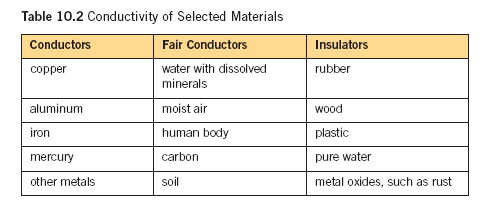
Since electrons cannot move through an insulator they can be very useful to us to protect us from shocks. For example a simple electric kettle would be very hazardous if the two wires that supplied electricity to it did not have a rubber coating over them
See Table pg 308 for some common insulators and conductors.
___________________ are good conductors since e’s can jump from one atom to the next
_________________ are insulators since they hold their e’s tightly
Why do you get more shocks in the winter than in the summer?
The Electrical Nature of Matter
electric charge- can be positive or negative
_____________- they have an even number of positives and negatives
an object has a ____________charge if it has more negatives than positives |
|
an object has a _____________charge it it has fewer negatives than positives |
The Law of Electric Charges- like charges ____________one another, unlike charges ____________ one another, charged objects are attracted to uncharged objects
A Model for the Electrical Nature of Matter : The atom is composed of electric charges.
Protons –____________charge, found in nucleus, cannot move
Neutrons- _______________charge, found in nucleus, cannot move
Electrons- _______________charge, found orbiting nucleus, can move from atom to atom
A model for the electrical nature of matter.
Charging by contact (Friction) pg 302
When two objects made of different materials rub together, electrons can be transferred from one object to the other.
This is because different atoms (which make up the objects) have a different ability to attract electrons and a different ability to hold onto their own electrons.
The Electrostatic Series
-a list of common materials showing how their ability to hold onto their electrons compares
acetate |
Weak hold on electrons
Strong hold on electrons |
glass |
|
wool |
|
fur, hair |
|
calcium, magnesium, lead |
|
silk |
|
aluminum, zinc |
|
cotton |
|
paraffin wax |
|
ebonite |
|
polyethelene (plastic) |
|
carbon, copper, nickel |
|
rubber |
|
sulphur |
|
platinum, gold |
To determine what charges will form, compare the location on the table of the two objects. The object that is higher on the table will ______________ electrons and become _________________. Eg. when cotton and human hair rub what charge will form on each object? ___________ is lower on the list than ___________. __________ will hold its electrons better. ____________ will lose its electrons to the ________________Cotton will become ___________. Hair will become ________________Consider the following pairs are rubbed together. Give charge on each : Plastic ________ Silk _______; Fur __________ Rubber ; glass ____ silk ______
Vinyl ______ Plastic ______ ; Ebonite _________ wool _____________
Questions
1. Where are electrons in the atom?
2. What does “static” mean in “static electricity”?
3. What happens when two objects made out of different materials are rubbed together?
4. What term describes an atom’s tendency to hold on to electrons?
5. In each of the following pairs, state which one is more likely to give up electrons.
(a) wood or human hair
(b) plastic wrap or steel
(c) cotton or silk
Complete pg 300 ( 1-4 ) pg 306 (1-5 )
Day 2 Induction (pg 303)
Charging by induction- charging without direct contact
When a negative charge approaches a neutral object, the electrons inside the neutral object are _____________. This causes an induced __________ charge on the side closest to the negative object and an induced ___________ charge on the opposite side. |
Diagram When a positive charge approaches a neutral object, the electrons inside the neutral object are ____________. This causes an induced __________ charge on the side closest to the positive object and induced __________charge on the opposite side. |
If a ground is attached to the neutral object, electrons can flow into or out of it to make it “feel” neutral.
Diagram
Induction is used in photocopiers, lightning, dust filters and electrostatic painting.
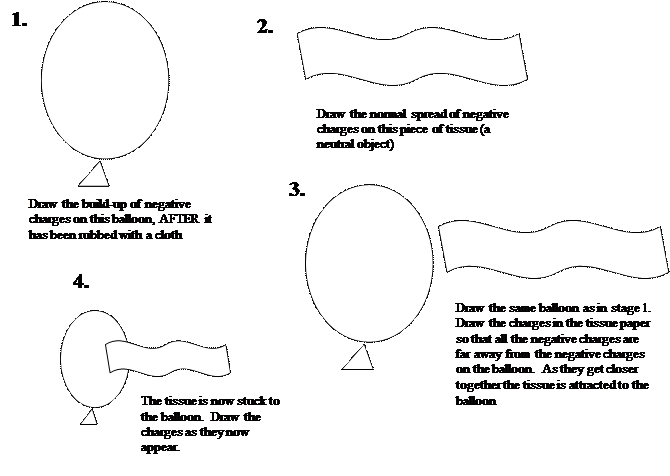 CHARGE BY INDUCTION
CHARGE BY INDUCTION
-no direct contact (e- move within a substance because of nearby objects)
(-) object goes near neutral object, (-) charge is repelled, (+) charge is attracted in neutral object
(+) charge is induced by (-) object
(+) object goes near neutral object, (+) charge is repelled, (-) charge is attracted in neutral object
(-) charge is induced by (+) object
When a neutral object is given a temporary charge, this is called _____________. If the object with a temporary charge is light enough it can be _____________ towards the object that caused the temporary charge.
Conclusion : objects charged by induction receive the _________________ charge to the charged object ; in the case above it is temporary ; the charge can become permanent if grounding is used.
GROUNDING -earth is large and absorbs large numbers of electrons, ground wire is connected to earth to "dilute"the charge by carrying it to the earth
____________________________________________________________________________________
_______________________________________________________________________
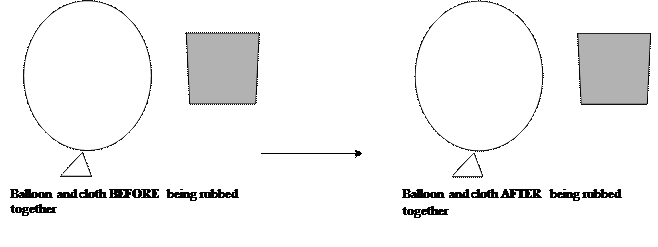 CHARGE BY CONTACT
CHARGE BY CONTACT
-rub material to build up electrons on object (-) or lose electrons from object (+)
(+) object touches neutral object and takes e-, both objects now have e- spread out, both are (+)
(-) object touches neutral object and gives e-, both objects now have extra e-, both are (-)
The negative charges will jump from the places where there are the most number to where there are the least. Complete the following diagrams by adding negative charges (electrons) or a static electricity spark:

Negative charges (or electrons) will always move from where there are the (greatest/fewest) number to where there are the (greatest/fewest) number. If there is a big enough difference and the two objects are close enough together, this jumping may cause a ____________. . see page 309. Where we see the greatest spark when the air is dry or when there is high humidity ? _______________________________
Conclusion : charging by contact the neutral object becomes the _________________ charge as the charging object.
Day 3 PITH BALL ELECTROSCOPE LAB
Purpose: To use a pith ball electroscope to determine charges.
Materials and Methods:
Observations:
step 1 |
|
step 2 |
|
step 3 |
|
step 5 |
|
Questions: (Answer on a separate sheet)
a) |
How to charge an ebonite rod negatively. |
b) |
How to charge a pith ball electroscope negatively with an ebonite rod. |
c) |
How the pith ball electroscope reacts to an ebonite rod after both have been charged negatively and the rod is brought close. |
Purpose: To charge a metal leaf electroscope by induction.
Materials and Methods: (If at any time the leaves stick together, touch the metal ball with your fingers and use a pencil to GENTLY separate the leaves)
![]()
![]()
Questions: (Answer in full sentence on separate page)
Charging Neutral Objects By Induction
Rod (+) à Object (-)
Rod (-) à Object (+)
Scenario #1 – Charging Using a Positive Rod
Step 1: Start with a positively charged rod (+).
Step 2: Approach the positive rod to the object (+) without touching it.
Step 3: Electrons inside the object are attracted to the rod. Only the electrons move closer to the rod but they do not jump.
Step 4: Add a grounding wire but keep the negative rod close to the object.
Results: The electrons from the ground enter the object (opposite charges attract)
Step 5: Remove the grounding wire first. Pull the rod away second.
The object is now permanently charged by induction
and it has become negatively charged.
Scenario #2 – Charging Using a Negative Rod
Step 1: Start with a negatively charged rod (-).
Step 2: Approach the negative rod to the object (-) without touching it.
Step 3: Electrons inside the object are repelled by the rod. Only the electrons move away from the rod but they do not jump out of the object.
Step 4: Add a grounding wire but keep the negative rod close to the object.
Results: The electrons from the object are repelled and move down the wire and into the ground (like charges repel).
Step 5: Remove the grounding wire first. Pull the rod away second.
The object is now permanently charged by induction
and it has become positively charged.
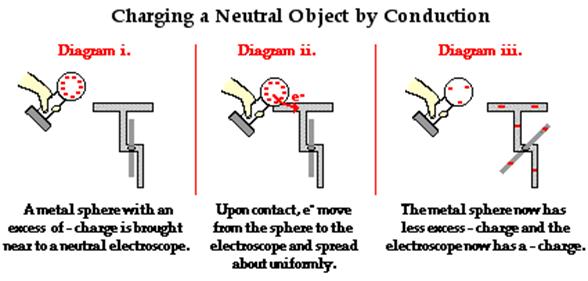
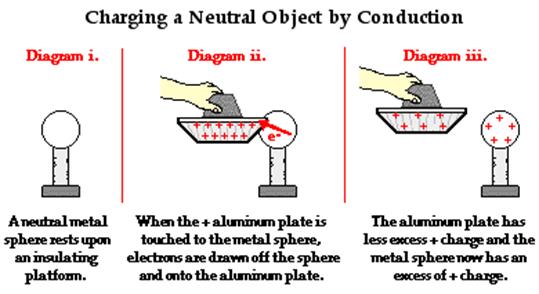
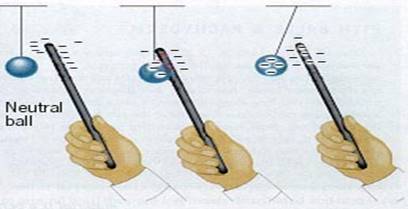
watch on youtube : What is Static Electricity ? ( Animation )
go to http://www.stmary.ws/highschool/physics/home/review/StaticElectricityReview.htm try animations
Key Concept Review
1. (a) Draw a diagram of an atom that has four protons, five neutrons, and four electrons.
(b) Label each particle with its name and whether it is positive (+), negative (–),or neutral.
2. (a) What is friction?
(b) Explain how friction can be used to transfer electrons. Use two substances from the triboelectric series in your answer.
3. Explain why this statement is false: “A neutral object contains no charge.”
4. State the two laws of static electric charges.
5. Where are static charges held?
6. Why might a plastic rod that contains a large number of electrons not have a static charge?
7. (a) What is the difference between a conductor and an insulator?
(b) What is an example of a conductor?
(c) What is an example of an insulator?
8.Do two identical objects become statically charged when you rub them together? Explain why they do or do not.
9. What does an electroscope detect?
10. In the contact method of charging, what charge does a neutral substance gain compared to the object that touched it?
11. In induction, what charge does a neutral substance gain compared to the object brought near it?
12. What is the difference between charging by contact and charging by induction in terms of electron transfer?
13. What is grounding?
Day 5 LIGHTNING
(pp. 313-315)
Strong ___________ and the collision of ___________ _____________ and ___________ _______________ in the clouds strip ___________________ from some particles and deposit them on others. Strong updrafts in the _______________ of the ___________________ carry smaller ____________ crystals and particles up while larger ones fall down. __________________ charges collect at the ________________ of the clouds whereas the higher, ________________ parts of the clouds are _________________ charged.
The negative charges on the ___________________ of the clouds repel _________________ on the surface of the ___________________, leaving the ground _________________ charged just below the cloud. This is an example of charging by ___________________ (contact? friction? induction?). The strong _____________________ between the __________________ cloud and the ____________________ ground pull ___________________ off atoms and molecules in the air. This occurs mostly over the _____________________ point on the ground.
A chain of ______________ forms and a gigantic ___________________ occurs between the _________________ and the ____________________. So many ___________________ crash through the air so fast, colliding with other _____________________, that the air both __________________up and __________________ up (ie. the temp. can reach ____________________ near a lightning bolt). The heat causes the air to __________________ rapidly. ______________ molecules colliding with other ____________ molecules produce a _____________ wave that we hear as _____________________. If the lightning hits a person, it can stop the ___________________ or _______________________.
The best way to control a lightning strike is to direct the flow of _______________ away from buildings and prevent fires. Electrons travel most easily through ___________________. ___________________ rods are based on this principle.
A lightning rod is charged by ___________________, just like the sphere on your ___________________. The _______________ charged lightning rod is the ____________________ point in the area. It attracts the ____________________ ions that have formed in the ______________, while the cloud attracts the ___________________ ions. A chain of ____________ thus forms between the cloud and the lightning rod. This chain acts as a ____________________ providing a path for the __________________ _________. When the lightning bolt strikes, it hits the ___________________ __________. The ____________________ are carried into the _________________ by a heavy conductor, often made of braided ________________.
Although the light from lightning travels so fast it almost takes no time to reach us. But the sound from the thunder takes about __________ seconds to travel one _________________. Imagine you heard thunder six seconds after you saw a lightning flash. How far are you from the lightning bolt? ___________ km.

Van de Graaff Electrostatic Generator
The American physicist Robert Jemison Van de Graaff invented the Van de Graaff generator in 1931. This device has the ability to produce extremely high voltages (as high as 20 million volts).
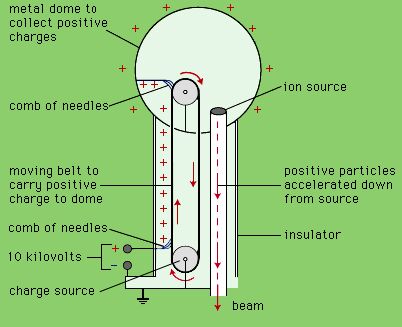 |
|
When the motor is turned on, the lower roller (charger) begins turning the belt. Since the belt is made of rubber and the lower roller is covered in silicon tape, the lower roller begins to build a negative charge and the belt builds a positive charge.
As long as there is air between the lower roller and brush assembly, the Van de Graaff generator will continue to charge the belt. Theoretically, the Van de Graaff generator can continue to charge forever. Unfortunately, dirt and other impurities in the surroundings will limit the actual charge that develops on the sphere.
- watch video on youtube : Bill Nye The Science Guy on Static Electricity (Full Clip)
SNC1D Name _______________________________
Static Electricity Assignment: The Practical Use of Static Charges
You have now seen three different ways that static charges can be gained by substances:
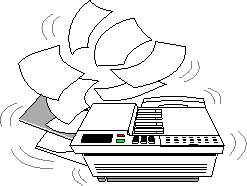 Much of our discussion of Static Electricity has focused on some of the negative effects (lightning strikes, and shocks for instance). This assignment deals with some of the more positive uses of static charges.
Much of our discussion of Static Electricity has focused on some of the negative effects (lightning strikes, and shocks for instance). This assignment deals with some of the more positive uses of static charges.
Photocopying
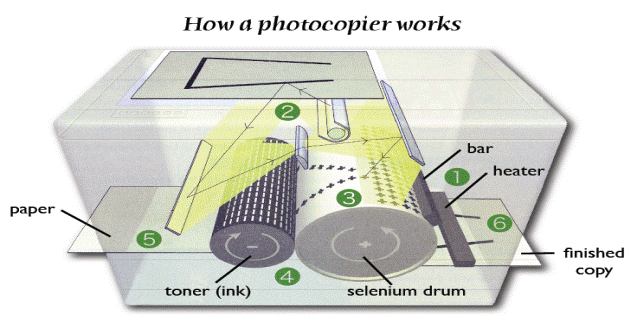
Many people are unaware of the fact that common photocopy machines make use of static electric effects. While the motors and lamps within the photocopier work on current electricity ( the topic of the 2nd part of this unit) the photocopy process itself uses static charges.
Summarize the process by completing the following (read page 310 in your text)
Inside a photocopier…
In this space summarize the following uses of static electricity
Electrostatic precipitators _______________________________________________________________________
_______________________________________________________________________________
_______________________________________________________________________________
_______________________________________________________________________________
_______________________________________________________________________________
Electrostatic spray guns ________________________________________________________________________
_______________________________________________________________________________
_______________________________________________________________________________
_______________________________________________________________________________
_______________________________________________________________________________________
Try this on your own!
Electrical Discharging( pgs 311-312 )
Independent Research
analyse the design of a technological device that improves its electrical efficiency or protects other devices by using or controlling static electricity (e.g., paint sprayers, photocopiers, lightning rods, grounding wires)
Questions:
How does eliminating static electricity help or hinder the performance of a device?
How have static electricity controls helped in developing new technologies?
Day 6 Electricity and Electric Circuits p. 324
Electric current: The movement or flow of electric charges from one place to another.
Electric circuit: A controlled path for electrons to flow through.
The 4 parts of an electric circuit:
1. Source of Electrical Energy- eg. solar cells, batteries, wall outlets
2. Electrical Load- anything that converts electrical energy into another form of energy eg. lamp, motor
3. Electric Circuit Control Device- turn flow on or off eg. timer, switch, fuse, circuit breaker
4. Connectors- allow electrons to flow from part to part eg. wires
Schematic diagrams
o Use circuit symbols instead of drawings of components
o Simpler to read, no artistic talent needed.
o Universal method of communicating circuits.
Copy the symbols on pg 324 /600 used to represent the following components of a circuit:
Part |
Symbol |
Function |
Part |
Symbol |
Function |
Cell |
|
|
Voltmeter |
|
|
3 cell battery |
|
|
Ammeter |
|
|
Wall outlet |
|
|
Conducting wire |
|
|
Switch |
|
|
Ground connection |
|
|
Fuse |
|
|
|
|
|
Resistor |
|
|
|
|
|
Light bulb |
|
|
|
|
|
Water Flow Analogy |
Electric Circuit |
|
|
Electric Current pg 325
|
Electric Current |
Definition |
a measure of the rate at which charges move past a certain point in a circuit |
Symbol |
________________ |
SI unit |
________________ |
Measuring device |
Ammeter connected in _____________(pg 600) |
Safety |
The more current, the more electrons that travel into you, the more damage that can occur. Current causes your heart to stop beating.0.005 A is maximum safe amount of current |
Compared to water |
Water in a river vs water in a stream. They may both move at the same speed (energy) but the river has more potential to do work because there is more water in it (more current) |
The flow of current from batteries direct current (DC)because the current flows in only one direction but the current that flows through cords plugged into the wall sockets in your home is called alternating current. Alternating current (AC) flows back and forth at regular intervals called cycles. This is the current that comes from generators and is carried by the big power lines to your home.
Electric Potential pg 330
Definition |
The energy difference between electrons at two locations in a circuit |
||
Symbol |
___________ |
||
SI unit |
___________ |
||
Measuring device |
Voltmeter connected in __________________________ (601) |
||
Safety |
The higher the voltage, the more energy electrons can release. This can result in burns when they release heat energy. |
||
Compared to water |
A waterfall has potential energy that is transferred to the water to make a river run. If the river looped back to the waterfall, a complete circuit would be made. The water is like electrons. |
||
- electric potential is measured in volts and electric potential is often called voltage (symbol V)
Analogy
Electricity from Chemical Reactions
As the electrons move through the circuit, they release the energy to the electrical load in the circuit |
|||
Day 7 Electrochemical Cells pg 383
ELECTROCHEMICAL CELLS -stored chemical energy is converted into ________________energy ; consists of ____________________ and an ___________________________
PRIMARY CELLS (disposable energy)
- electrical current flows from primary cells, and chemical reactions occur, using up some material
-when all material is discharged, primary cell is used up
(a) VOLTAIC CELLS - non-rechargeable primary cell
-two pieces of ____________ (electrodes) placed in liquid (_________________________)
ELECTRODE -electrical conducting plate in solution eg. Al, Cu
ELECTROLYTE -liquid that conducts electrical current eg. H2SO4
See diagram fig 12.3 page 383
- electrons flow from the __________________ to _______________________ through the ___________________________ __________________
- the aluminum electrode is called the anode and has a neg. charge
- aluminum atoms lose __________________ and become ______________________
- over time the aluminum electrode will get __________________________
- at the copper strip which is called the cathode and has a positive charge ______________ ions pick up electrons forming __________________ gas
Do lab activity pg 384. Copy out chart pg 384
Post Lab
1. Copper strip – evidence of a chemical reaction : formation of _________ ___________
2. As time passed booth the voltage and current __________________________
3. Potential difference was effected when a) aluminum was used instead of ____________ and when ___________________ metals were used
Current – removing bubbles _______________ current and decreasing surface area of the electrodes ______________________ the current.
4. Potential difference – combination of __________________ used and the length of time cell operated
5. Current was increased when the surface area of the metals was ________________ and when the bubbles of gas were ____________________.
6. Largest current was when the whole electrode was submerged and only a few bubbles were present.
7. _________________ and zinc produced the greatest potential difference
8. In designing a voltaic cell electrodes of _______________ and _________________ should be used and immersing them ________________ in the liquid. To increase the life of the cell _______________ the surface area of the electrodes.
- car battery is good example of a wet cell ; the negative electrode is made of _____________ and positive electrode is made of ___________________; the electrolyte is _____________________
- it is called a ______________________ cell since it can be recharged
Disadvantages of using Wet cells :
- the ________________ electrode is used up
- bubbles of ________________ gas form on the __________ electrode reducing __________ flow.
- _____________ gas is very _________________________
- the electrolyte __________________ acid is very _________________; may _________________ or ___________________.
(b) DRY CELLS (pg 387)
- works like a wet voltaic cell, but electrolyte is a ___________ or a ________(not a liquid)
advantages = less chance of spilling electrolyte ; explosive hydrogen gas is not produced
- negative terminal is made of ________________________
- positive terminal is a __________________ rod surrounded by ______________________
- separating the 2 electrodes is a paste made of ______________, _______________ and ____________________.
- 2 disadvantages : ______________________ and _________________________
Day 9 Lab : Building Batteries ( pg 390 )
|
Voltage |
Brightness of Bulb |
One Cell |
|
|
2 cells in series |
|
|
3 cells in series |
|
|
2 cells in parallel |
|
|
3 cells in parallel |
|
|
Analyze :
1. _____________________________________________________________
______________________________________________________________
2. ______________________________________________________________
______________________________________________________________
3. ______________________________________________________________
______________________________________________________________
Conclusion :
4. _____________________________________________________________
_____________________________________________________________
_____________________________________________________________
5. _________________________________________________________________________
_________________________________________________________________________
6. _________________________________________________________________________
_________________________________________________________________________
7. _________________________________________________________________________
_________________________________________________________________________
_________________________________________________________________________
Cells in Series and Parallel
Cells in Series
series circuits – one pathway for electrons, connected so that _________terminals touch _________terminals
parallel circuits – more than one pathway for electrons, connected so that negative terminals touch _____terminals
- As electrons travel through each new battery, they get a new boost of energy.
Eg. If three 1.5 volt cells are connected in series, electrons receive 1.5V from each cell.
1.5 + 1.5 + 1.5 = 4.5V total
- This is similar to water travelling down subsequent waterfalls. As it falls over each one, the water travels faster.
Cells in Parallel
o Electrons only travel through one cell.
o The extra cells act as backup and the cells last longer.
Eg. If three 1.5V cells are connected in parallel, electrons receive 1.5V energy only.
o This is similar to two waterfalls on rivers next to each other. Water only travels down one waterfall.
Complete pg 394 (1-3)
Day 10 Lab Activity: Loads in Series
Purpose: To investigate the characteristics of electric circuits with loads in series.
Materials: 2 cells, 3 bulbs, 3 bulb holders (sockets), connecting wires, voltmeter and ammeter (or digital multimeter)
Method:
Observations:
Electric Potential (V) Two cells connected in series:______V |
|||
# of bulbs |
Across bulb #1 |
Across bulb #2 |
Across bulb #3 |
1 |
|
|
|
2 |
|
|
|
3 |
|
|
|
*hint for teacher: the sum of the electric potential across each row should be 3.0 V.
Current (A) |
||||
# of bulbs |
After battery |
After bulb #1 |
After bulb #2 |
After bulb #3 |
1 |
|
|
|
|
2 |
|
|
|
|
3 |
|
|
|
|
Questions:
_______________________________________________________________
____________________________________________________________________________
b) How many paths for current flow are there in a series circuit? ________________
_____________________________________________________________________
________________________________________________________________________________
Schematic Diagrams :
1.
2.
3.
Day 11 Lab Activity: Loads in Parallel
Purpose: To investigate the characteristics of electric circuits with loads in parallel.
Materials: 2 cells, 3 bulbs, 3 bulb holders (sockets), connecting wires, voltmeter and ammeter (or digital multimeter)
Method:
Observations:
Electric Potential (V) Two cells connected in series:_______V |
|||||||
# of bulbs |
Across bulb #1 |
Across bulb #2 |
Across bulb #3 |
||||
1 |
|
|
|
||||
2 |
|
|
|
||||
3 |
|
|
|
||||
Current (A) |
|||||||
# of bulbs |
After battery |
After bulb #1 |
After bulb #2 |
After bulb #3 |
|||
1 |
|
|
|
|
|||
2 |
|
|
|
|
|||
3 |
|
|
|
|
|||
Questions:
6. Suppose 15 light bulbs were connected in series, and one bulb burned out. How could the defective bulb be found? _______________________________________
______________________________________________________________________
______________________________________________________________________
Schematics :
1.
2.
3.
Investigation Parallel and Series Circuits (pg 360)
The Series Circuit:
current flows through a ____________path consisting of parts of the circuit which are wired to one another
Analogy (fig 11.1 pg 354)
Electrons push on the electrons ahead resulting in a smooth, even flow of current.The current at any one point in a series circuit is exactly the same as the current as any other point in the circuit. A series circuit can be compared with a race track. Cars are like electrons flowing around in a series circuit. All cars are filled with gas at a pit stop and travel smoothly around the same closed path.
The Parallel Circuit:
current flows through ________________paths called __________ circuits Analogy (fig 11.2 pg 355)SP
In a parallel circuit, charges flow around two or more different loops. After leaving the power source, some charges take one path, while other charges take the other. A parallel circuit is like city streets where Cars have many paths to travel. One path might be a six lane freeway, while another is a two lane side street. Like cars on a freeway compared to a side street, the current in a parallel circuit is not the same at different points.
The fact that electrons in a series circuit flow around a single path and electrons in a parallel circuit flow around in different paths (branches) brings us to the following Laws.
Current Law:
At any connection in an electric circuit, the current flowing into the connection is equal to the total current flowing out of the connection.
Series: It = I1 = I2 = I3 Parallel: It = I1 + I2 +I3
Voltage Law:
The algebraic sum of the potential differences around any closed pathway or loop must equal zero.
Series: Vt = V1 + V2 + V3 Parallel: Vt = V1 = V2 = V3 .
Sketch schematics below for a series and parallel circuit . See page 354 and 355. Diagram A ; 3 1.5 cells in series; Current from source = 1 amp ; 3 bulbs connected in series
Diagram B : 3 1.5 V cells in series ; current = 1amp ; 3 bulbs connected in parallel
Complete page 358 ( 1-4 )
Series CircuitOne path for the electricity to flow means that charges making up the current flow from one load to the next moving through all loads until coming back to the source again. |
Parallel Circuit |
Series |
Parallel |
Is = I1 = I2 = I3 |
Is = I1 + I2 + I3 |
|
|
The current passing through each of the 3 resistors and the current entering and leaving the source are exactly the same. |
The sum of the current passing through the 3 resistors is the same as the current entering and leaving the source. |
I. Use the Electricity Book web site to answer the next few questions
http://www.uce.ac.uk/education/research/cript/electricity%20book/frame%20start.htm
Start with the section Series and Parallel
Series – Explain what happens when the bulb breaks?
Paralle1 – Explain what happens when the bulb breaks?
Christmas Tree with bulbs in series – Why do newer Christmas tree lights use parallel circuits?
II. Use the Ohm Zone to answer these questions and complete listed activities.
http://www.article19.com/shockwave/oz.htm
Follow the hand and select Building a Simple Circuit first to see how the program works. Notice that this web site shows the flow of current from the positive side to the negative side but our course (and Ministry of Education) requires that we use the model with the flow from the negative terminal of the battery (excess electrons) to the positive terminal of the battery (deficiency of electrons).
Click on the hand again and select Building a Series Circuit this time. In a series circuit, elements are connected _____ after __________. This provides ______________________________________________. Follow the instructions to remove the bulb. If a connection in a series circuit is broken, the current _________ through all other elements will ____________.
Click on the hand again and select Building a Parallel Circuit. A ________ circuit provides two or more _______ for the current to follow. In the circuit, notice that the current flows from the battery to point A, where it _____________________________. Try out the activity. At point B, the 2 ____________________________________ into ___________ to return to the battery. If one of the parallel connections is broken, _____________________________________________________________________.
Click on the hand again and select Building Combination Circuit. Try out the activity and read this section. Notice the combination circuits follow the principles of series circuits in the areas that have series connections and follow the principles of parallel circuits in the areas that have parallel connections.
Click on the hand again and select Current in a Series Circuit. The current intensity in a ________ circuit is the _________ through each circuit element. Try moving the ammeter around to see what the reading is at each point in the circuit.
Click on the hand again and select Current in a Parallel Circuit. In parallel circuits, the current intensity will be highest in the circuit element that has the lowest resistance (true because of Ohm’s Law). To find the current (I) first find the resistance (R) by hovering over each element. Next, use the voltmeter to find the potential difference (V). You can find the current now by using Ohm’s law (V=IR, I=V/R) or you can just use the ammeter to check it. Add up the current reading at A, B, and C to get a reading of ____A. Now place the ammeter after the battery and notice the reading is 1.15 A too! This means that Is=IA + IB + IC for parallel circuits.
Complete CYU 11.1 2,4 using www.tina.com or paper and pencil to make drawings and find the current at different points in the circuits.
III. For additional review and problems use the bite size website
http://www.bbc.co.uk/scotland/education/bitesize/standard/physics/electricity/series_and_parallel_circuits_rev1.shtml
Review Parallel And Series Circuits and answer question 1.
Move to Current in a Series Circuit and try the activity.
Move to Current in a Parallel Circuit and try this activity. This is good review.
![]() WORKING WITH CIRCUITS
WORKING WITH CIRCUITS
1. Label the parts of Figure A with the following terms:
chemical (energy) source
electrical (energy) conductor
light and heat (energy) load
______________ energy
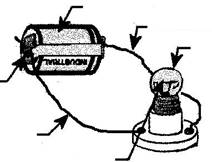
_____________ energy
_____________ energy
Figure B |
2. What kind of circuit is this? __________________ 3. How many paths do the electrons have to follow? _______ |
4. How many loads does this circuit have? ______
5. Is the circuit complete or incomplete? _______________
6. Are the loads working? __________
7. If one bulb were to blow out, the other bulb would _________________
8. Adding another bulb would make the other two give off
less light / the same amount of light? (circle one)
Figure C |
9. What kind of circuit is this? _____________ 10. How many loads does this circuit have? ________ 11. How many paths do the electrons have to follow? ______ |
12. Is the circuit complete or incomplete? __________________
13. Are the loads working? ______________
14. If one bulb were to go off, the other bulb would give off
less light_/ the same amount of light__ (circle one)
15. Adding another bulb would make each bulb give off
less light_/ the same amount of light__ (circle one)
16. Is this a good way to wire a home? ____________
Figure D
|
17. What kind of circuit is this? _____________________ 18. How many paths do the electrons have to follow? ___________ 19. How many loads does this have? _________ Name them. ____________ ___________ |
Continue referring to Figure D.
20. Is the circuit complete or incomplete? ________________
21. Are the loads working? ________________
22. Is your home wired this way?_____________
Figure E |
Look at Figure E
23. What kind of circuit is this? _______________________
|
24. How many paths do the electrons have to follow? _________
25. How many loads does this circuit have _________
Name them ________________ __________________
26. How many switches does this circuit have? ________
27. Which appliance is working?____________________
28. Which appliance is not working? ________________
29. Is your home wired this way? ___________
Look at Figure F
30. What kind of circuit is this? _________________________
31. How many paths do the electrons have to follow? ________
32. How many loads does this circuit have? __________
Name them ______________________________________
Figure F 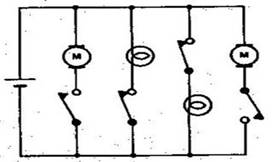  |
|
33. How many switches does this circuit have? _________
34. Which loads are working? ___________________________
COMPLETE THE CHART (Place a check in the correct column)
|
Parallel Circuit |
Series Circuit |
1. only one path for the electricity |
|
|
2. more than one path for the |
|
|
3. loads work or shut off one at a |
|
|
4. all loads are on or all loads are |
|
|
5. appliances share the voltage |
|
|
6. appliances do not share the |
|
|
7. good way to wire a home |
|
|
8. not a good way to wire homes |
|
|
9. an extra bulb makes the others |
|
|
10. an extra bulb does not change |
|
|
Day 12
|
Electric Circuits with Multiple Loads |
||
|
|
Electric Current |
Electric Potential |
|
Series |
Constant It= I1= I2… |
Energy is shared by the loads. The sum of the loads should equal the source voltage. |
|
Parallel |
Each pathway allows a certain amount of current to flow. The sum of each pathway is the total current for the circuit. |
Each pathway receives the same energy. The potential difference for each pathway is the same as the source. Vt= V1= V2… |
Advantages of a series circuit:
1. Less energy (voltage) is used.
2. Simpler to set up.
3. Less current= safer
Disadvantages of a series circuit:
1. One load stops, all stop.
2. One switch controls all loads.
Advantages of a parallel circuit:
1. Loads are independent.
2. Loads get maximum voltage.
Disadvantages of a parallel circuit:
1. More current with each load- can be unsafe.
2. Uses more energy.
Electricity Search
connectors |
amps |
protons |
kinetic |
battery |
load |
cell |
thermal |
switch |
volts |
circuit |
wire(s) |
voltage |
electrons |
light bulb |
electrical |
static |
Chemical |
physical |
|
|
A |
|
B |
|
C |
|
D |
|
E |
|
F |
|
G |
|
H |
|
I |
|
J |
|
Day 13 Electrical Resistance and Ohm’s Law (pgs. 337– 339)
Electrons move easily through a good conductor e.g _____________is a good conductor. Electrons l________ very little energy when they collide with __________atoms as they move through. Thus, little electrical energy is converted into ____________.
Tungsten, the filament in light bulbs, is a _________conductor. Electrons lose much more of their energy when they collide with tungsten atoms. Thus, much electrical energy is converted into heat and light. Tungsten’s resistance is ______________ x that of copper’s resistance
The ability of a substance to impede the flow of electrons is called ___________. Some electrical devices used in circuits are designed for this purpose and are called __________. The symbol of electrical resistance is _______, and the SI unit is the ______ ( ).
When electrons flow through a conductor, the electrical resistance causes a _________ of electric potential (voltage). This loss is referred to as electric potential difference, voltage drop, or the potential difference across a conductor.
resistors- are designed to impede the flow of electrons
Symbol: R
SI Unit: Ohm (Ω)
Voltage Drop – depends on resistance and amount of current
V= IR Ohm’s Law
Potential Difference (Voltage Drop) = Current x Resistance
Ohm’s Law only applies to “ohmic resistors”. They are not affected by temperature changes.
FACTORS THAT AFFECT RESISTANCE (342)
a. TEMPERATURE
-higher temperature, _________resistance (harder for electrons to flow through disorganized, fast moving electrons)
b. LENGTH
- ____________ resistance with wire length (resistance __________as length doubles...harder to flow greater distance relative to shorter distance)
c. CROSS SECTIONAL AREA
- ____________ resistance with larger area (more area for electrons to flow...easier)
d. MATERIAL
-structure of atoms may allow electrons to move better or worse, depending on how well atom holds onto electrons
Day 14 Resistance
Voltage or Potential = Current x Resistance
Difference (Amperes) (Ohms)
(Volts)
V = I x R
I = V / R
R = V / I
Potential Difference (Volts) |
Current |
Resistance |
12 |
4 |
|
9 |
3 |
|
6 |
2 |
|
3 |
1 |
|
![]()
Current
(amps)
![]()
|
Current |
Resistance |
Voltage |
(a) |
0.1 |
600 |
|
(b) |
0.25 |
1000 |
|
© |
0.4 |
|
240 |
(d) |
0.5 |
|
240 |
(e) |
|
1000 |
200 |
1. (a) straight line graph (b) R = 3 ohms 2.(a) volt (b) amp (c) ohm 3. Voltage measured by voltmeter wired in parallel; Current measured by ammeter wired in series 4. 1.2volts 5. 120 ohms 6.0.4 ohms 7. 800 ohms ; Add them if they are in series to get 2400 ohms 8. (a) 60 volts (b) 250 volts (c)600 ohms (d) 480 ohms (e) 0.5 amps
Resistance Calculations Worksheet
resistance = potential difference
current
R = V Units: R is Ω (ohms)
I V is V (volts)
I is A (amperes)
1. Find the unknown quantity:
a) I = 10 A
|
b) I = ?
|
c) I = 15 A
|
2. Find the unknown quantity (CONVERT FIRST to the unit with no prefix)
a) I = ?
|
b) I = 25 mA = _________ A
|
c) I = 1 kA = ________ A
|
WORD PROBLEMS
1. How much resistance does a light bulb create if it has a current of 25 mA around it in a 9 V circuit?
2. A heating coil offers a resistance of 2.5 kΩ. What voltage is required so that 1.5 A of current pass through it?
3. The human body offers a very small amount of resistance (let’s say 1 mΩ for argument). If a lightning bolt (said to have 1.21 GV of potential according to a famous movie called Back to the Future released in 1984), hits you how much current is flowing through your body.
Complete page 342 ( 1-6 )
SNC 1D
Grade Nine Science
Complete this sheet after a review of your notes and chapter 10 of your text book.
_______________________________________________________________________________
_______________________________________________________________________________
_______________________________________________________________________________
_________________________________________________________________________________
_________________________________________________________________________________
Resistance = ----------------------
__________________________________________________________________________________
__________________________________________________________________________________
Energy ~ the ability to do work
Electrical Energy ~ The energy transferred to an electrical load by moving electric charges
If you connect a battery to any type of electrical load until it is discharged, multiply the voltage drop, current and time, you always get the same number. Scientists express this relationship in the form of a formula:
Electrical Energy = Voltage Drop x Electric Current x Time Interval
E = V x I x Dt
Where E is the electrical energy measured in joules (J)
V is the voltage drop measured in volts (V)
I is the electric current measured in Amperes ( I)
andDt is the time interval measured in seconds (s)
Rated Capacity = Electric Current x Time Interval
ENERGY SYSTEM
-a device that converts one form of energy into another
eg. electric kettle converts electrical energy into sound and thermal energy
FIRST LAW OF THERMODYNAMICS -"energy is not created or destroyed, it just changes forms"
INPUT ENERGY = WASTE ENERGY + USEFUL OUTPUT ENERGY
input energy = amount of energy used to operate a system
output energy = amount of useful energy obtained from a system
waste energy =energy that is not useful (often thermal)
unit of energy = Joule (J) = 1000 J = 1 kJ (kilojoule)
EFFICIENCY =[ENERGY OUTPUT / ENERGY INPUT] X 100
eg. 500 kJ energy goes to electric kettle, which uses 490 kJ to heat water,and loses 10 kJ as heat and sound
kettle efficiency = E out/ E in X 100 = 490 kJ / 500 kJ = 98 % efficiency
waste = 100 % - 98% = 2 % energy wasted
Efficiency Calculations ( pg 348 )
Questions
Calculating Electric Power
Electrical power is a measure of the rate at which electrical energy is being used.
The SI unit is the watt and the symbol is W.
Electrical Power (E) = Electrical Energy (J) = Watts
![]() Time Interval (s)
Time Interval (s)
Answer in:
Watts
Joules
seconds
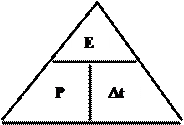 Formulae
Formulae
![]() P = E
P = E
Dt
P x Dt
E
P
This formula is not often used because you have to measure both the energy and the time interval to be able to solve the problem.
Although the joule (J) is the normal unit for energy, the large amounts of energy used in a home would require the use of very large numbers. In the electrical meter, the energy is measured in kilowatt hours (kW.h). Power is measured in kW and time is measured in hours (h). There are 3 600 J in one W.h or 3 600 000 J in one kW.h.,
Power can also be calculated using the voltage and current:
Electrical Power = Voltage Drop x Electric current
Answer in:
Watts
Volts
Amps
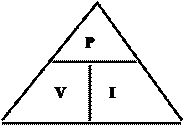 P = V x I
P = V x I
P
I
P
V
To find the cost of the electricity, multiple the rate charged by the electric company by the energy used.
Examples:
ELECTRICAL POWER PROBLEMS
1. Calculate the power rating of an electric toaster that uses 210 000 J of Energy while toasting bread for 140 s (time).
2. Calculate the power rating of a coffee grinder that operates on a voltage of 120V. A current of 1.7 A flows in the motor.
3. Calculate the Energy used by a coffee maker that has a Power rating of 0.900 kW and operates for a time of 17 h.
4. How much Energy is used by a 1.5 kW (P) electric kettle that operates for a time of 0.80 h per day for two weeks.
5. What is the current (I) drawn by a 100 W light bulb operating at a voltage drop of 120 V?
6. What is the voltage drop across a 1248 W baseboard heater that draws 5.20 A ?
7. What is the maximum power that may be used in a circuit with a voltage drop of 120 V
and a 20 A fuse?
8. Calculate the cost of operating a 3.6 kW oven for 3.0 h, at a rate of $0.08/kW·h.
9. Calculate the cost of operating a 400 W spotlight for 2.0 h a day for 30 days , at a rate of
$0.08/kW·h.
10. What is the cost to a store owner of leaving a 40 W light burning near his safe over the
weekend, for 60 h, if electricity costs $0.08/kW·h?
11. The blower motor on an oil furnace, rated at 250 W, comes on for an average of 5.0 min
at a time, a total of 48 times a day. What is the monthly (30 day) cost of operating the
motor, if electricity costs $0.08/kW·h?
12. A 300 W refrigerator compressor operates for an average of 6 h per day. Calculate the
annual cost of operating the refrigerator, if electricity costs $0.08/kW·h.
Ans. 1) 1500 W 2) 204 W 3) 15.3 kW·h 4) 16.8 kW·h 5) 0.833 A 6) 240 V
7) 2400 W 8) $0.86 9) $1.92 10) $0.19 11) $2.40 12) $52.56
Pg 348 (1-5)
Day 19 Electrical Energy Use in the Home (368)
What unit is used to measure the amount of energy your house uses? ________________
Look at the meter on page 368 :
October 28 # of kilowatt hours (kW.h) = ____________________
August 30 # of kilowatt hours (kW.h) = ___________________
Subtract the 2 values = _____________________ = amount of kW.h used
If the cost = 8.0 cents per kW.h .
Calculate the total cost = total energy used kW.h x cost in $/kw.h
___________ x ___________= ____________________
The Price of Energy
electricity costs eight cents per kW•h, how much will it cost to operate the toaster for one year?
Calculations:
Pg 350 (1-6),8,11,13,14,17,20,21,22,23,24,25,26,27,28
Pg 378 (1-7),8,10,11,17,21,22
Independent research
produce a plan of action to reduce electrical energy consumption at home (e.g., using EnerGuide information when purchasing appliances), and outline the roles and responsibilities of various groups (e.g., government, business, family members) in this endeavour [IP, AI, C]
Issue: Replacing incandescent light bulbs with compact fluorescent bulbs can reduce the energy needed to light a home by 75%. Although the bulbs are more expensive than incandescent bulbs, electrical companies sometimes provide coupons to reduce the price. Also, the Ontario government is phasing out incandescent bulbs, which will further reduce energy consumption.
Questions:
What are EnerGuide and ENERGY STAR, and how can they be used when purchasing appliances or electronics?
What is the difference in energy consumption between a conventional and a front-loading washing machine?
What appliances consume electrical energy even when they are not in use?
Which Light Bulb Is Best?
Light bulbs are used for many different purposes in a home. In your own room, you likely have a desk lamp, a ceiling light, and maybe a bedside lamp. Bulbs used to come in standard wattages of 40, 60, and 100 W. Now, different energy-efficient types of bulbs are available.
How much longer do these new bulbs last? Are they cost-efficient as well?
1. How many kilowatt-hours does a 60-W incandescent bulb use during a 12-hour period?
______________________________________________________________________________________
______________________________________________________________________________________
2. How many kilowatt-hours does a 15-W compact fluorescent bulb use during the same period? (Both bulbs provide the same light intensity of 900 lumens.)
______________________________________________________________________________________
______________________________________________________________________________________
3. If the utility rate is $0.10 per kW•h, how much does it cost to run each light bulb in questions 1 and 2?
______________________________________________________________________________________
______________________________________________________________________________________
4. According to the information on their packages, the compact fluorescent bulb lasts 10 000 hours and the incandescent bulb lasts 1350 hours. How much money will you save in electricity charges over the life of each bulb?
______________________________________________________________________________________
______________________________________________________________________________________
5. If the compact fluorescent bulb costs $30.00 to buy and the incandescent bulb costs $2.00 to buy, which bulb is more economical over the long term? (Hint: To make this comparison, assume 10 000 hours of operation. This will require purchasing more than one incandescent bulb, so you will need to determine how many.)
______________________________________________________________________________________
______________________________________________________________________________________
______________________________________________________________________________________
______________________________________________________________________________________
Source: http://www.dpcdsb.org/NR/rdonlyres/309C82E5-7722-497D-A23A-FF871B996955/63133/unit3electricitynotes.doc
Web site to visit: http://www.dpcdsb.org/
Author of the text: not indicated on the source document of the above text
If you are the author of the text above and you not agree to share your knowledge for teaching, research, scholarship (for fair use as indicated in the United States copyrigh low) please send us an e-mail and we will remove your text quickly. Fair use is a limitation and exception to the exclusive right granted by copyright law to the author of a creative work. In United States copyright law, fair use is a doctrine that permits limited use of copyrighted material without acquiring permission from the rights holders. Examples of fair use include commentary, search engines, criticism, news reporting, research, teaching, library archiving and scholarship. It provides for the legal, unlicensed citation or incorporation of copyrighted material in another author's work under a four-factor balancing test. (source: http://en.wikipedia.org/wiki/Fair_use)
The information of medicine and health contained in the site are of a general nature and purpose which is purely informative and for this reason may not replace in any case, the council of a doctor or a qualified entity legally to the profession.
The following texts are the property of their respective authors and we thank them for giving us the opportunity to share for free to students, teachers and users of the Web their texts will used only for illustrative educational and scientific purposes only.
All the information in our site are given for nonprofit educational purposes
The information of medicine and health contained in the site are of a general nature and purpose which is purely informative and for this reason may not replace in any case, the council of a doctor or a qualified entity legally to the profession.
www.riassuntini.com